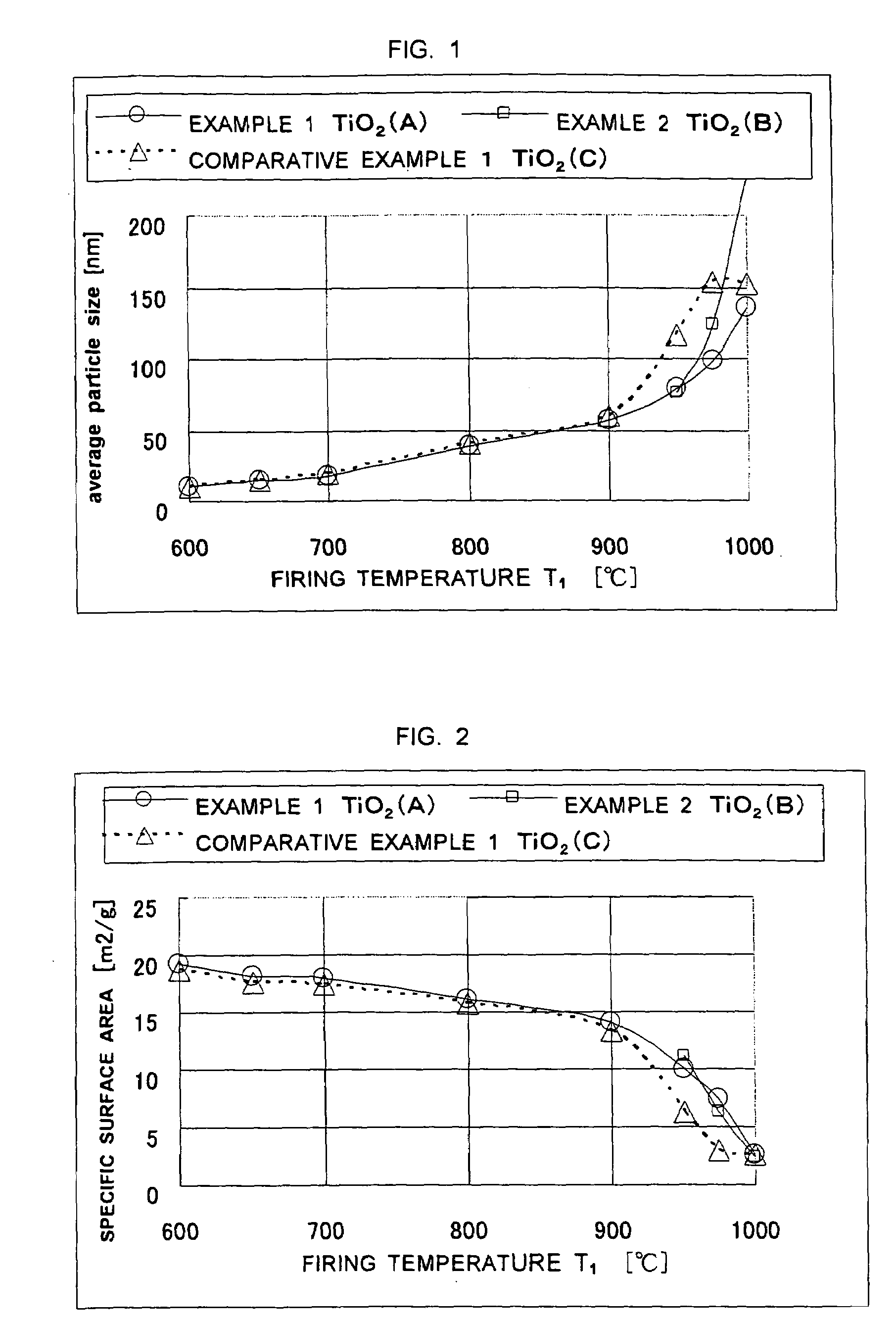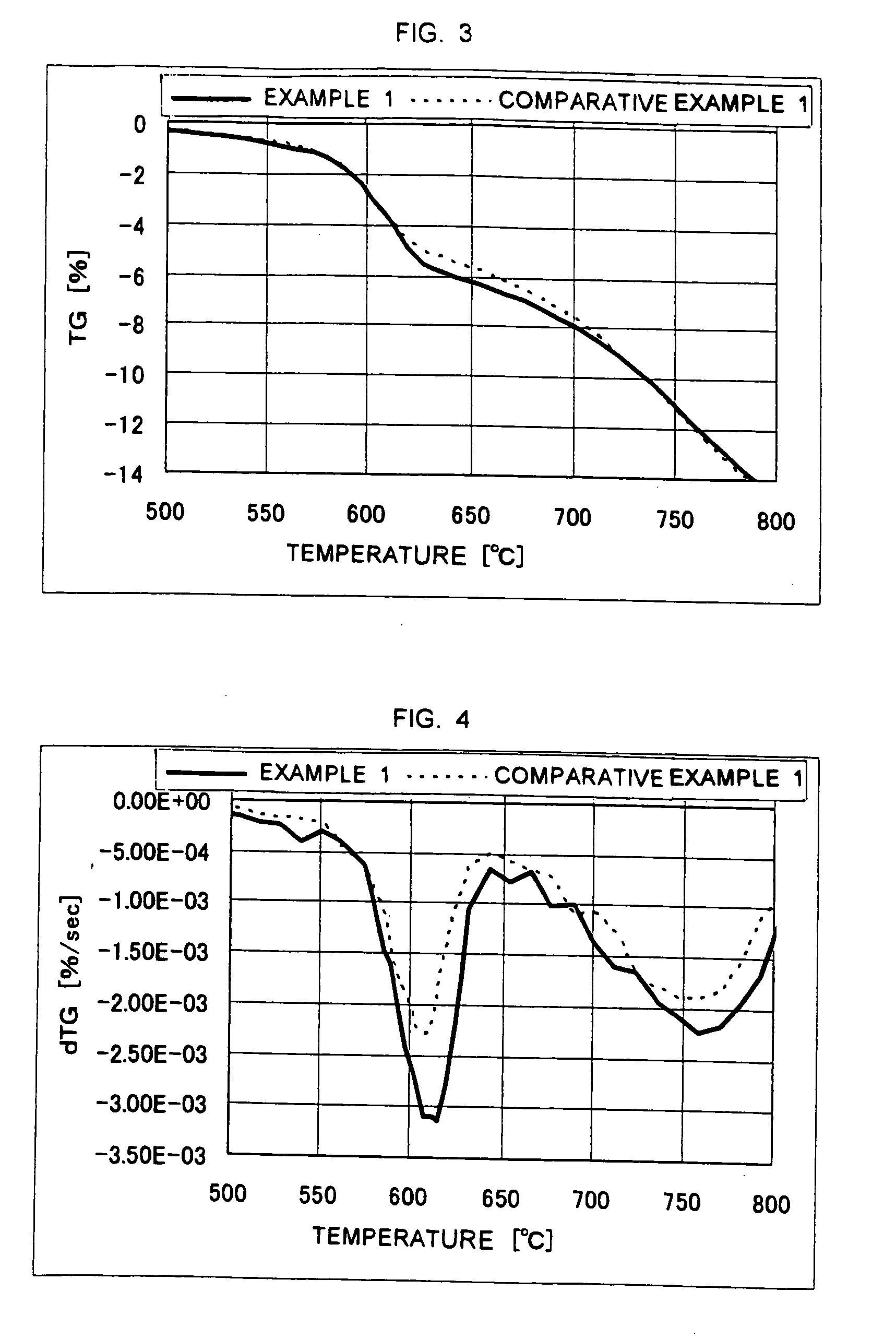Method for producing dielectric powder
a technology of dielectric powder and dielectric powder, which is applied in the direction of titanium compounds, ceramics, inorganic insulators, etc., can solve the problems of poor particle size distribution, difficult atomization of barium titanate powder, and worse capacitance temperature properties of multi-layered ceramic capacitors, etc., to achieve uniform grain properties, high tetragonality, and fine particles
- Summary
- Abstract
- Description
- Claims
- Application Information
AI Technical Summary
Benefits of technology
Problems solved by technology
Method used
Image
Examples
example 1
[Preparation of Blended Powder]
[0078]Weighing barium carbonate powder having specific surface area so as to be 30 m2 / g and titanium dioxide powder (TiO2(A)) so as to be 0.997 Ba / Ti proportion, wet blending for 72 hours by a ball mill using zirconia (ZrO2) medium, then the blended powder is obtained after drying. The wet blending is made under condition that slurry concentration is 40 wt %, adding 0.5 wt % polycarboxylate type dispersing agent. Here, since the titanium dioxide powder is fine particle having large specific surface area, it is necessary to blend the raw material sufficiently.
(Heat Treatment for Blended Powder)
[0079]Temperature rising was made from a room temperature to heat treatment temperature T1 shown in Table 1, under air-atmosphere, temperature rising rate of 3.3° C. / min (200° C. / min) by an electric furnace (batch furnace). Then, keeping 2 hours at the heat treatment temperature, then after cooled by 3.3° C. / min (200° C. / min). This heat treatment condition is defi...
example 2
[0082]Except for using TiO2(B) as titanium dioxide powder, similar procedure as in Example 1 was repeated. Result is shown in Table 2.
example 3
[0092]Except for using TiO2(A) as titanium dioxide powder with heat treatment process (B), specimen of barium titanate powder is prepared as similar with Example. Results of EXAMPLE 1 and EXAMPLE 3 are shown in Table 3.
TABLE 3AverageSpecificAverageFiringparticlec / asurfaceparticleRaw Materialtemp. T1size d—XRDproportionareasize d—BETTiO2Process[° C.][nm][—][m2 / g][nm]tetragonalityUsageExample 1TiO2(A)process (A)10001381.0102.66396AbasematerialExample 1TiO2(A)process (A)900601.00814.0375BinhibitorExample 1TiO2(A)process (A)800401.00516.0466CinhibitorExample 3TiO2(A)process (B)9251421.0104.00263AbasematerialExample 3TiO2(A)process (B)900721.00911.0795Abasematerial
[0093]In the table, as an index of tetragonality, c / a>1.009 is shown as “A”, c / a>1.007 is shown as “B”, c / a2 / g or more is preferable as inhibitor. In usage of the inhibitor, although tetragonality may be “B” or “C”, the higher is preferable.
[0094]In the present invention, by reducing the surface chlorine, abnormal particle grow...
PUM
| Property | Measurement | Unit |
|---|---|---|
| Fraction | aaaaa | aaaaa |
| Fraction | aaaaa | aaaaa |
| Fraction | aaaaa | aaaaa |
Abstract
Description
Claims
Application Information
 Login to View More
Login to View More - R&D
- Intellectual Property
- Life Sciences
- Materials
- Tech Scout
- Unparalleled Data Quality
- Higher Quality Content
- 60% Fewer Hallucinations
Browse by: Latest US Patents, China's latest patents, Technical Efficacy Thesaurus, Application Domain, Technology Topic, Popular Technical Reports.
© 2025 PatSnap. All rights reserved.Legal|Privacy policy|Modern Slavery Act Transparency Statement|Sitemap|About US| Contact US: help@patsnap.com


